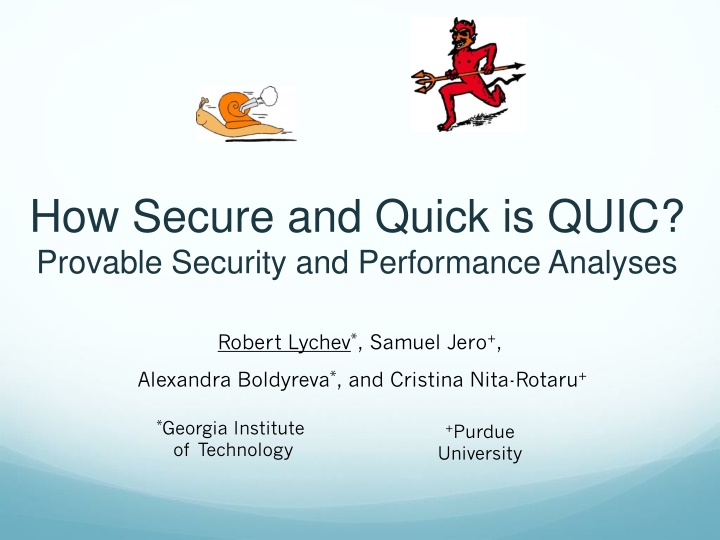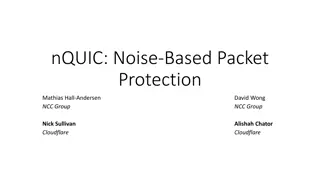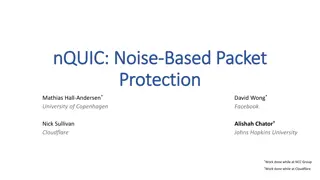
QUIC: Security and Performance Analysis
"Explore the security and performance aspects of QUIC protocol in online businesses, focusing on latency reduction and connection establishment while maintaining security standards. Learn about the implications of QUIC on security and the efficiency compared to traditional TLS. Discover the setup time comparisons and how QUIC enables faster data exchange while ensuring protection against attackers."
Download Presentation

Please find below an Image/Link to download the presentation.
The content on the website is provided AS IS for your information and personal use only. It may not be sold, licensed, or shared on other websites without obtaining consent from the author. If you encounter any issues during the download, it is possible that the publisher has removed the file from their server.
You are allowed to download the files provided on this website for personal or commercial use, subject to the condition that they are used lawfully. All files are the property of their respective owners.
The content on the website is provided AS IS for your information and personal use only. It may not be sold, licensed, or shared on other websites without obtaining consent from the author.
E N D
Presentation Transcript
How Secure and Quick is QUIC? Provable Security and Performance Analyses Robert Lychev*, Samuel Jero+, Alexandra Boldyreva*, and Cristina Nita-Rotaru+ *Georgia Institute of Technology +Purdue University
Minimizing Latency Proliferation of mobile and web applications has made latency a very important issue for online businesses - users might visit a web site less often if it is slower than a competitor by over 250ms, S. Lohler NY Times 2012 - 100ms latency costs Amazon 1% in sales, G. Linden, 2006 Bandwidth is cheap and will continue to grow, but information cannot travel faster than the speed of light m my internets are so slow! y internets are so slow! Challenge Challenge: minimize number of : minimize number of RTT s to establish establish a a connection, connection, without RTT s required required sacrificing security to without sacrificing security
What is QUIC? Google s answer to the latency challenge Stands for Q Quick U UDP I Internet C Connections Communication protocol developed by Google and implemented as part of Chrome browser in 2013 Was designed to - produce security protection comparable to TLS - reduce connection latency Can QUIC do this in presence of attackers? Can QUIC do this in presence of attackers?
Setup Time: QUIC vs TLS TLS over TCP TLS over TCP QUIC QUIC TCP session establishment connection establishment and key agreement client server server client setup latency + + TLS key establishment exchange data TCP guarantees ordered delivery, provides protection against connection-spoofing, but - adds latency - suffers from subtle performance attacks, e.g., TCP reset, Clayton et al, 2006 exchange data What about QUIC?
Starting Data Exchange: QUIC vs TLS TLS TLS QUIC QUIC server client server client session key establishment initial key establishment data exchange with initial key data exchange with session key session key establishment Parties can often avoid 1 RTT in initial key establishment of QUIC by caching some parameters (achieving 0-RTT connections) data exchange with session key What implications does this have on security?
Previous Work on QUIC Fischlin & G nther, ACM CCS 2014 - develop a security definition for multi-stage key agreement and show that QUIC s key exchange meets this definition - show how to modify QUIC so that it can compose with any secure data exchange protocol - prove QUIC s key exchange with a modification is secure What about security of the whole protocol as is? What about its latency in presence of attackers?
Main Questions We Address 1. What provable security guarantees does QUIC provide, and under which assumptions? 2. How effective is QUIC at minimizing latency in presence of attackers?
Summary of Our Results 1. What provable security guarantees does QUIC provide, and under which assumptions? - we develop a security definition suitable for performance driven protocols and show that QUIC satisfies it - QUIC does not satisfy the traditional notion of forward secrecy, provided by some TLS modes, e.g., TLS-DHE 2. How effective is QUIC at minimizing latency in presence of attackers? - with simple attacks on some parameters, it is easy to prevent QUIC from achieving its minimal latency goals - we have implemented these attacks and demonstrated that they are practical
Outline 1. Provable Security Analysis of QUIC a. how QUIC works b. new protocol and security models c. security of QUIC 2. QUIC Performance-degradation attacks 3. Summary and Future Work
QUIC Protocol client server c_i_hello: (cid) $ cid {0,1}64 -generate stk based on client s IP s_reject: (cid, scfg, stk) -verify scfg signature -generate DH values (secc, pubc) -establish initial key using scfg c_hello: (cid, stk, scfg, pubc) -verify stk -establish initial key using pubc initial data exchange -generate session DH values (secs,pubs) s_hello: (cid, pubs) -establish session key using pubs -establish session key using pubc data exchange - cid: connection id picked by the client - stk: source-address token used to prevent spoofing - scfg: server config contains server s public Diffie-Hellman (DH) values can be reused
QUIC Protocol Connection Resumption client server 1 RTT $ cid {0,1}64 -generate DH values (secc, pubc) -establish initial key using scfg - c_hello: (cid, stk, scfg, pubc) -verify stk -establish initial key using pubc initial data exchange -generate session DH values (secs,pubs) s_hello: (cid, pubs) -establish session key using pubs -establish session key using pubc data exchange - cid is the new connection id picked by the client - stk can be reused before expiration - scfg can be reused before expiration
QUIC Protocol Connection Resumption client server -can achieve 0-RTT connections! $ cid {0,1}64 -generate DH values (secc, pubc) -establish initial key using scfg - c_hello: (cid, stk, scfg, pubc) -verify stk -establish initial key using pubc initial data exchange -generate session DH values (secs,pubs) s_hello: (cid, pubs) -establish session key using pubs -establish session key using pubc data exchange -client cannot initially check stk authenticity, so this can lead to inconsistent view of the handshake -compromising the server before scfg expires can reveal data encrypted with initial key
Security Analysis Main Challenges Previous analyses of TLS are not suitable (Jager et al, Krawzcyk et al, Bhargavan et al, Crypto 2012, 2013, 2014) - data in QUIC can be exchanged using initial key before the session key is set Parties can set distinct initial keys - notion of having a matching conversation is not sufficient - need new notion of setting a key with to capture data privacy scfg is public and can be reused before it expires - need weaker notion for forward secrecy for initial keys - use traditional notion of forward secrecy for session keys UDP does not address unordered delivery and spoofing - need to capture attacks involving misordering, selectively delaying or dropping packets, and connection spoofing
Security Analysis Main Challenges To address these challenges we developed - protocol model that captures data exchanges under initial key before session key is set: Quick Communications (QC) - security notion: Quick Authenticated and Confidential Channel Establishment (QACCE)
How Secure is QUIC? QUIC meets our notion of QACCE-security if The underlying signature scheme is suf-cma - QUIC supports ECDSA-SHA256 and RSA-PSS-SHA256 The underlying AEAD scheme is ind-cpa and auth-secure - QUIC uses AES Galois-Counter Mode (GCM), McGrew et al, INDOCRYPT 2004 SCDH Problem is hard In the random oracle (RO) model - model HMAC with RO in the key derivation
Outline 1. Provable Security Analysis of QUIC 2. QUIC Performance-degradation attacks a. types of performance-degradation attacks on QUIC b. performance-degradation attacks we have implemented 3. Summary and Future Work
Performance Attack Overview Replaying public, cacheable content, e.g, scfg and stk - results in fooling client and/or server parties into trying to achieve a connection and maintain state Manipulating unprotected packet fields, e.g., cid & stk - leads clients and server to have a distinct view of the key exchange resulting in a failure to establish a session key The attacks we have studied - cause servers and clients to waste time and resources - stem from parameters whose purpose was to minimize latency, e.g., scfg and stk - do not concern data authenticity and confidentiality
Attacks We Have Implemented targeted QUIC Chromium implementation from October 1, 2014 used Python scapy library (http://www.secdev.org/projects/scapy/) Attack Name Attack Name Attack Type Attack Type Impact Impact scfg Replay Attack Replay Connection Failure stk Replay Attack Replay Server DoS cid Manipulation Attack Manipulation Connection Failure, Server Load Manipulation Connection Failure, Server Load stk Manipulation Attack Crypto Stream Offset Attack Other Connection Failure Attacks can be used to deny clients access to any application of choice and cause servers to waste resources!
Summary and Future Work Developed security definition for performance-driven protocols and showed that QUIC meets our definition Have implemented five different practical performance degradation attacks against QUIC low security latency Demonstrate an inherent tradeoff between performance and security Our security definition could be used to analyze other performance-driven protocols, such as TLS version 1.3
Thank You look for the full version 1. Security definitions and proofs 2. Attack implementation details 3. Comparison to attacks against TLS 4. Mitigation strategies






















